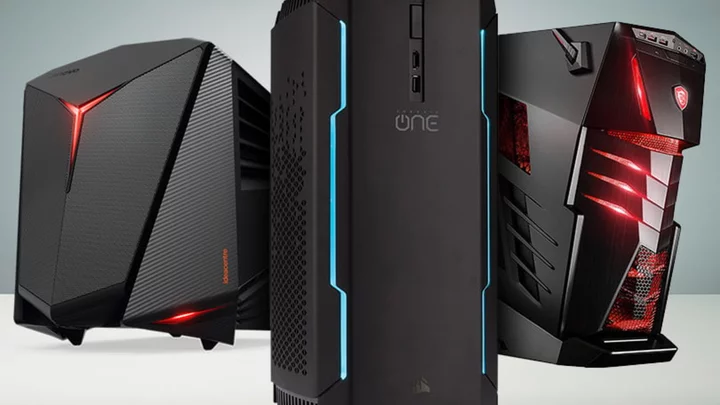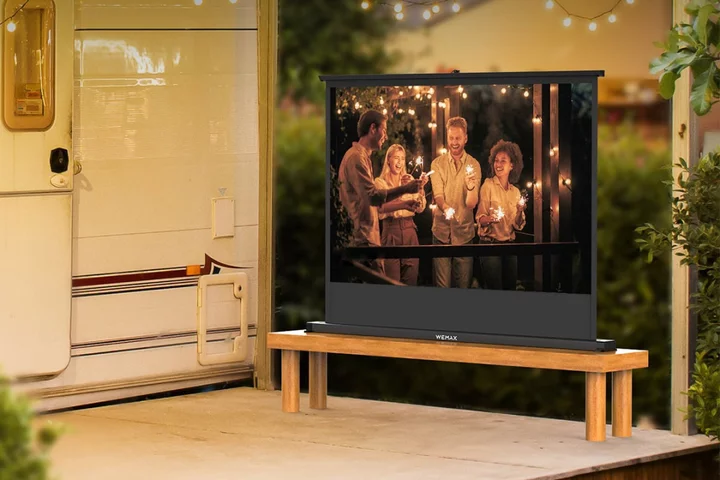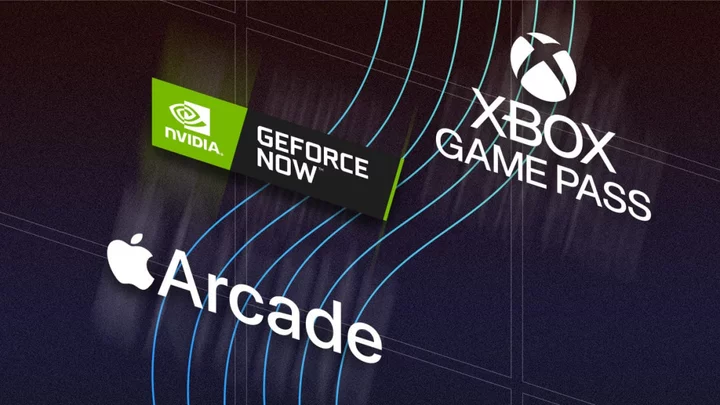Despite the allure and simplicity of gaming consoles and handheld devices, PC gaming has never been stronger. Enthusiasts know that nothing beats the quality of gameplay you can get with a desktop built for gaming. And today, it's within almost every determined PC shopper's grasp to get a PC with the graphics power necessary to drive the latest games on a full HD (1080p) monitor at lofty detail settings.
What kind of desktop PC makes games look and run better than on the Sony PS5 or Microsoft Xbox Series X? If you have deep pockets, it's a custom-built hot rod from an elite boutique PC maker, such as Falcon Northwest, Maingear, or Velocity Micro. However, a few well-informed choices will go a long way toward buying the right gaming desktop from a mainstream brand, like Dell, Lenovo, or MSI—even if you're not made of money.
These are the best gaming desktops in 2023 across all budgets and our latest top picks in the category. Every gaming PC we recommend has been thoroughly tested—from tower PCs to compacts—for a variety of uses. Our top picks are followed by a guide explaining how to buy the right gaming desktop for you and your budget.
First, Which Graphics Card Do I Need?
Most gaming systems will come preinstalled with a single midrange or high-end graphics card; higher-priced systems will naturally have better cards, since purchase price typically correlates with animation performance and visual quality. AMD and Nvidia make the graphics processors, or GPUs, that go into these cards, which are made by third parties such as Asus, EVGA, Gigabyte, MSI, PowerColor, Sapphire, and XFX (to name just a few).
The Nvidia GeForce RTX 4090 graphics cardGone are the days of complicated dual-card setups: Today's top-end GPUs, like Nvidia's GeForce RTX 4080 and RTX 4090, are more than good enough on their own. Games are increasingly developed to take advantage of the cutting-edge features available in single GPUs like these, but these premium cards will cost you.
AMD's Radeon RX 7900 XTX graphics cardStill, you should divert much of your budget to the best GPU you can afford; the most pivotal decision you'll make when purchasing a gaming desktop is which card you get. One option, of course, is no card at all; the integrated graphics silicon on modern Intel Core and some AMD processors is fine for casual 2D games and very light 3D gaming. However, to really bring out the beast on 3D AAA titles, you need a discrete graphics card, and these cards are what distinguish a gaming desktop from "just a desktop."
A PCMag-styled Origin PC Millennium 5000T gaming PCWhether you go with an AMD- or Nvidia-based card is based partly on price, partly on performance. Some games are optimized for one type of card or another, but for the most part, you should choose the card that best fits within your budget. If you're buying a complete gaming desktop, you of course don't have to pay for a card in isolation, but this should help you understand how the card factors into the total price. You also have to know what you're shopping for.
'Lovelace' Is Here: The State of Graphics Cards in 2023
For some time now, Nvidia has been dominant at the high end of the GPU battlefield. Since September 2020, this has been through its GeForce RTX 30 Series GPUs, such as the flagship GeForce RTX 3080 and top-end RTX 3090. Most recently, Nvidia launched its next generation of GPUs, the GeForce RTX 40 Series, based on new "Ada Lovelace" architecture—more on those cards in a moment.
The Nvidia GeForce RTX 3080 Founders EditionIn general, for both Nvidia and AMD GPUs, the first number in a model name denotes the GPU generation—RTX 4000 Series GPUs are Nvidia's latest, while AMD is up to the RX 6000 line—while the last two numbers denote the hierarchy within that generation. For example, the RTX 3080 is superior to the RTX 3070, and both replaced their RTX 2080 and RTX 2070 predecessors, respectively.
The 20 Series GeForce RTX cards were the first to offer ray tracing (putting the "RT" in "RTX"), a fancy real-time-lighting feature that only cards with the RTX moniker are capable of running. (See our primer on ray tracing and what it means for PC gaming.)
Another angle on the GeForce RTX 3080Nvidia's RTX 30 Series is based on its "Ampere" architecture, which replaced the "Turing" design of the RTX 20 Series. Now, the RTX 40 Series seeks to do the same to the RTX 30 Series with its "Lovelace" architecture, though it seems likely the RTX 30 Series will remain relevant for some time.
The top-end cards are certainly pricey propositions, too costly for many shoppers, and difficult to find available in 2023. The RTX 3080 Founders Edition launched with a $699 MSRP, as much as some whole computers on its own, but actually a better value than the RTX 2080. The RTX 3070 launched at $499, making it a very palatable choice, and the RTX 3060 at an even more attainable $329. Pricing on these cards went haywire in 2020-2021, but have returned, to an extent, to earth.
Going up the stack even further than the RTX 3080, the GeForce RTX 3090 is a professional-grade replacement for the Titan RTX coming in at $1,499. You could use it for gaming, but it's not remotely twice as fast as an RTX 3080 for more than double the money. If you are one of the rare few who need even more power, Nvidia went even further by releasing the RTX 3090 Ti in March 2022 for an eye-watering $1,999.
Nvidia's GeForce RTX 4090 Founders EditionWhy will these RTX 30 Series GPUs likely stick around a while? The prices for the new RTX 40 Series cards are to blame. The RTX 4090, though it shows tremendous power in our review, is extremely pricey at $1,599; and the RTX 4080 isn't much better at $1,199. The 30 Series still offers playable performance and is way more capable of ray tracing than the 20 Series; plus, supply is available, and 40 Series GPUs are prohibitive for many budgets.
Unfortunately, these prices seem to be the new normal. Lower-end 40 Series GPUs have launched behind their top-end siblings to provide more options, though: The RTX 4060 Ti Founders Edition is an effective 1080p card for $399, for example. These lesser GPUs will help accelerate the phasing out of the RTX 30 Series...eventually.
GPU availability issues plagued 2020, 2021, and much of 2022, though those problems started to recede as we moved into 2023, and the RTX 40 Series launch helped further. If you haven't been paying attention to the graphics card space, it had been difficult to actually acquire these GPUs at retail price, or in general, since 2020. You could (and can still) pay over the odds from resellers (some of who gobbled up many cards with the intention of reselling them at a higher price), but otherwise had to play the lottery with intermittent restocks from key sellers like Best Buy and Newegg. Read our explanation here of why these graphics cards were so difficult to purchase.
The rolling RTX 40 Series launch has been helping improve matters in 2023 on the card-availability front, but the list prices are also higher. Though you can find these cards in stock more easily now than you could their predecessors in 2020-2022, the hefty list prices make these a significant buy.
This is one reason why buying a prebuilt gaming desktop, like the desktops in our list here, makes a lot of sense: easier access to the parts you want, without price gouging. Pre-built PCs from major manufacturers or boutique vendors are one of the most accessible ways to acquire a top GPU in 2023 because they take care of acquiring GPU stock for you to buy in their systems.
Digital Storm's Lynx gaming desktop in its many colorsFor owners of older GeForce GTX 10-Series "Pascal" cards, it was a tough call on whether to upgrade to the GeForce RTX 20 Series. The raw performance gains were modest, and ray tracing, while attractive, was a difficult proposition even on the best RTX 20 Series GPUs. If you've held out this long, with the RTX 30 Series still impressing so much and the RTX 40 Series still fresh, we can much more fully recommend that enthusiasts make the jump if you can find any newer-generation GPU on a good deal. We recommend the newest GPUs even more emphatically if you play (or plan on playing) on a 1440p or 4K monitor.
Affordable Nvidia Alternatives...and Don't Forget AMD
While you may still see the occasional older system with Nvidia's Turing GPUs out there (the GeForce GTX 1650, the GTX 1660, the GTX 1660 Ti, and their variants), these have been mostly phased out for at least RTX 30 Series GPUs, if not RTX 40 Series cards.
Nvidia GeForce RTX 4060 TiShoppers looking for an entry-level or midrange system have many options. On the lower end, the GeForce RTX 3050 and RTX 3060, RTX 3060 Ti, and RTX 4060 Ti are more budget-friendly to varying degrees, but still very solid 1080p cards. (The GeForce RTX 4060 is slated for a late June 2023 release.) An RTX 3060 Ti or RTX 4060 Ti system will fit the bill for high-frame-rate 1080p gaming (and capable 1440p gaming, in some cases). You can try ray tracing on a per-game basis or just turn it off to your preference.
Meanwhile, inside prebuilt gaming PCs, AMD competes mainly in the midrange and low end, with its Radeon RX cards, and its midrange offerings are looking better now than they have for a long time. In mid-2019, AMD launched its first "Navi" graphics cards, based on an all-new architecture. Then, AMD's late-2020-to-2022 offerings in the high end, the Radeon RX 6800 and the Radeon RX 6800 XT, pushed closer to Nvidia's top cards more than AMD had in many years. When they're at their best, they're close to equal with Nvidia's RTX 30 Series GPUs for a little less money, but it depends on the game in question.
AMD closed the value-proposition gap even further in late 2022: The AMD Radeon RX 7900 XTX and 7900 XT, which start at $999 and $899, really push Nvidia's RTX 40 Series GPUs on cost-to-performance. Nvidia still holds the power crown, but AMD's cards have a strong case with their pricing. More recently, AMD pushed its case further with the AMD Radeon RX 7600 as a go-to value play for solid 1080p gaming.
AMD Radeon RX 7900 XTXAMD also has midrange Radeon cards that compete, albeit a bit less successfully, with midrange GeForce. On the AMD side, check out the reviews and see which seems like the best fit for your needs and budget. But you'll definitely see more GeForce cards than Radeon ones in prebuilt desktops.
Prep for 4K Gaming and VR, or Keep It Real?
Equipping your system with any high-end GPU will boost your total PC bill by a few hundred dollars. Beyond adding extra power to your gaming experience, some graphics cards can power up to four displays, and few gamers go beyond three (and even then only rarely).
A better reason to opt for high-end graphics, in the long run, is to power 4K and virtual reality (VR) gaming. Monitors with 4K resolution (3,840 by 2,160 pixels) and the displays built into the latest VR headsets have much higher pixel counts than a "simple" 1080p HD monitor. You'll need at least a single high-end graphics card to drive a 4K display at the highest quality settings, with similar requirements for smooth gameplay on VR headsets. If you mean to play games on a 4K panel with detail settings cranked up, you'll want to look at one of Nvidia's highest-end cards suited for 4K play, with the RTX 3080, RTX 4080, and RTX 4090 easily the best picks.
A closeup of the Falcon Northwest FragBox gaming PCSelecting a graphics card for VR is a different set of considerations, and not quite as demanding as 4K play on recent AAA games. VR headsets have their own graphics requirements. But for the two big ones from HTC and Oculus, you'll want at least a GeForce GTX 1060 or an AMD Radeon RX 480 or Radeon RX 580. Those are older-generation cards, of course; check for specific support for a given Nvidia GeForce Turing/Ampere/Lovelace or AMD Radeon Navi card if that is what you will be getting. Generally, a GeForce GTX 1660 Ti or a Radeon RX 5600 XT/RX 6700 (or higher, in either case) should suffice.
An angled view of the Falcon Northwest Tiki (2022) gaming desktopNow, VR and 4K gaming are unquestionably high-end matters (the latter even more so than the former). You can still get a rich gaming experience for thousands of bucks less by choosing a desktop with a single but robust middle-tier video card (an RTX 3060, 2060, or 2070, for example) and gaming at 1080p or 1440p; 2,560 by 1,440 pixels is an increasingly popular native resolution for gaming monitors. If you're less concerned about VR or turning up all the eye candy found in games—anti-aliasing and esoteric lighting effects, for example—then today's less-powerful graphics cards and GPUs will still give you plenty of oomph for a lot less money.
Which CPU Do I Need in a Gaming Desktop?
The parallel heart in any gaming system to its GPU is its main processor chip or CPU. While the GPU specializes in graphics quality and some physics calculations, the CPU takes care of everything else, and it also determines how able your PC will be for demanding tasks that require non-graphics calculations.
On the CPU front, AMD and Intel are in a race to see who can provide the most power to gamers. Mainstream speed lies chiefly with the Core i5, Core i7, and Core i9 CPU options on the Intel side, and the Ryzen 5, Ryzen 7, and Ryzen 9 on the AMD side.
An Intel Core i7 processor held in handThe most common mainstream CPUs range from $150 to $499, such as the AMD Ryzen 5 and Ryzen 7 lines, and Intel Core i5 and i7 CPUs. These provide the computing muscle needed for a satisfying gaming experience without breaking the bank, losing out mostly on some higher-end productivity and media creation capability rather than gaming performance.
This is the real sweet spot for gamers. On the higher end of midrange, you have chips like the Intel Core i7-12700K , AMD Ryzen 7 5800X, and (most recently) the Intel Core i7-13700K and the AMD Ryzen 7 7700X, which deeply impress in this category. The latter two are the flagship CPUs in Intel and AMD's latest processor platforms, 13th Gen "Raptor Lake" and the Zen 4-based Ryzen 7000, respectively.
Prior to Intel's Alder Lake, AMD's efforts put them on top of the CPU world for the first time in a long time. The Zen 3-based 5000 Series impressed on its debut, with chips like the Ryzen 7 5800X outperforming Intel, especially on media creation and editing tasks. Alder Lake gave Team Blue the edge again, but AMD's year-old solutions still remain competitive. These are still widely available and in many of the systems we recommend, even if they are not the latest AMD platform as of fall 2022.
That's because in late 2022 AMD launched its newest generation: Those Ryzen 7000 processors based on the new Zen 4 architecture. We tested and reviewed two of these chips at launch (the aforementioned Ryzen 7 7700X and the Ryzen 9 7950X), and both produce super-impressive performance across the board. However, they still couldn't quite top the best Alder Lake solutions for gaming.
That was not great news for AMD, and it got worse when Intel's Raptor Lake platform proved even faster when it launched in October 2022. The upshot is that consumers still have more options than ever. Also, at the very high end, AMD Ryzen 7000 is very much in play: AMD's recent launch of its latest specialized 3D V-Cache CPUs, notably the Ryzen 9 7950X3D and Ryzen 7 7800X3D, deliver targeted game boosts under some circumstances for extreme gamers using the very highest-end GPUs, notably the GeForce RTX 4090.
Gamers on a lesser budget should look to lower-priced (but still speedy) processors, such as the AMD Ryzen 5 or the Intel Core i5 lines, which will knock hundreds of dollars off the bottom line. This includes the latest chips like the Intel Core i5-13600K. The baseline has come a long way, so even these less expensive chips are well-suited to gaming. Even AMD's latest Ryzen 3 processors can get the job done if you're shopping on a very tight budget.
A sample AMD Ryzen 7000 processorAt the top of the Intel and AMD mainstream stacks, we have the Core i9 and Ryzen 9 tier. The Core i9-9900K was the first flagship Core i9 option, and the most recent powerhouse is the Intel Core i9-13900K, based on the 13th Gen "Raptor Lake" architecture. AMD's new Ryzen 9 7950X is the direct challenger to this chip. These are more expensive than the lower tiers: the i9-13900K, for example, is priced at $589, while the Ryzen 9 7950X (the fastest current mainstream chip you can buy) is listed at $699.
There's also an even greater tier you might see reference to as you shop, aimed less at consumers and gamers than workstation users: AMD's Ryzen Threadripper CPUs (a good example being the Ryzen Threadripper 3970X) and Intel's counter, the Core X-Series processors, in which the top "Extreme Edition" model flaunts 18 cores and 36 threads. Prices for these processors are traditionally high, but these platforms are falling into obsolescence for consumers; it's not essential to invest in one of these elite-level Threadripper or Core X-Series processors to enjoy excellent PC gaming. Most gamers do not need to shop in that tier, and these have taken a back seat in relevance. Neither Core X-Series nor Threadripper has seen a new consumer-oriented model in the last few years.
If your choice comes down to paying for a higher-level GPU or a higher-level CPU, and gaming matters most, favor the graphics, in most cases. A system with a higher-power Nvidia GeForce GPU and a Core i5 processor is generally a better choice for 3D-intense FPS gaming than one with a low-end card and a zippy Core i9 CPU. But you may want to choose the latter if you're into games that involve a lot of background math calculations, such as strategy titles (like those in the Civilization series), or if you also mean to use the system for CPU-intensive tasks, like converting or editing video, or editing photos, when you are not gaming.
How Much Memory and Storage Should I Get?
One thing that's often overlooked on gaming systems is RAM; it can be severely taxed by modern games. Outfit your PC with a bare minimum of 8GB of RAM, and budget for 16GB if you're serious about freeing up this potential performance bottleneck. The most powerful machines out there will pack 32GB, though there are diminishing returns for gaming beyond 16GB. (See lots more about how to choose RAM in our memory primer.)
Solid-state drives (SSDs), meanwhile, have become much more popular since prices began dropping dramatically a few years ago, and the price drops have accelerated especially over the last couple of years, unlike most PC components. They speed up boot time, wake-from-sleep time, and the time it takes to launch a game and load a new level. They are the de facto choice for boot drives now.
A WD Blue SN570 SSDAlthough you can get an SSD of any size up to around 4TB (with the larger 8TB capacity still being relatively rare and expensive), the pairing of a small one (a capacity of 500GB or 1TB is a good minimum floor to set) with a large-capacity spinning hard drive (8TB or more) is a good, affordable setup for gamers who download lots of games and want to keep them installed and local. You can keep a subset of your favorite games and applications on the smaller SSD, where they'll benefit from quicker loading, and install the bulk of your library on the hard drive.
Favor PCI Express SSDs over SATA ones. (The former, the performance darlings of the moment, are now the norm for boot drives in current-model desktop gaming systems.) Almost all of these drives come on gumstick-size modules in a format called M.2.
The Perfect Accessories
Don't stop at internal components. Once you have your ideal gaming desktop, a couple of extras can really enhance your gaming experience. We recommend that you trick out your machine with a top-notch gaming monitor with a fast refresh rate, as well as a solid gaming headset so you can trash-talk your opponents. A high-refresh-rate monitor can absorb the excess frame rates that a robust video card puts out, for smoother gameplay. In-monitor support for Nvidia G-Sync or AMD FreeSync, matched to your brand of video card, can also eliminate artifacts that result from varying frame rates.
An RGB keyboard is a PC-gaming staple.A comfortable gaming keyboard, gaming mouse, or specialized controller can round out your options at checkout, but know that oftentimes you're better off selecting these items separately, rather than limiting your selection to what's offered by the system seller.
So, Which Gaming Desktop Should I Buy?
Below are the best gaming desktops we've tested of late. Some are configured-to-order PCs from boutique manufacturers, but some come from bigger brands normally associated with consumer-grade desktops. Note that many of the same manufacturers also make gaming laptops, if you're weighing between the two.









